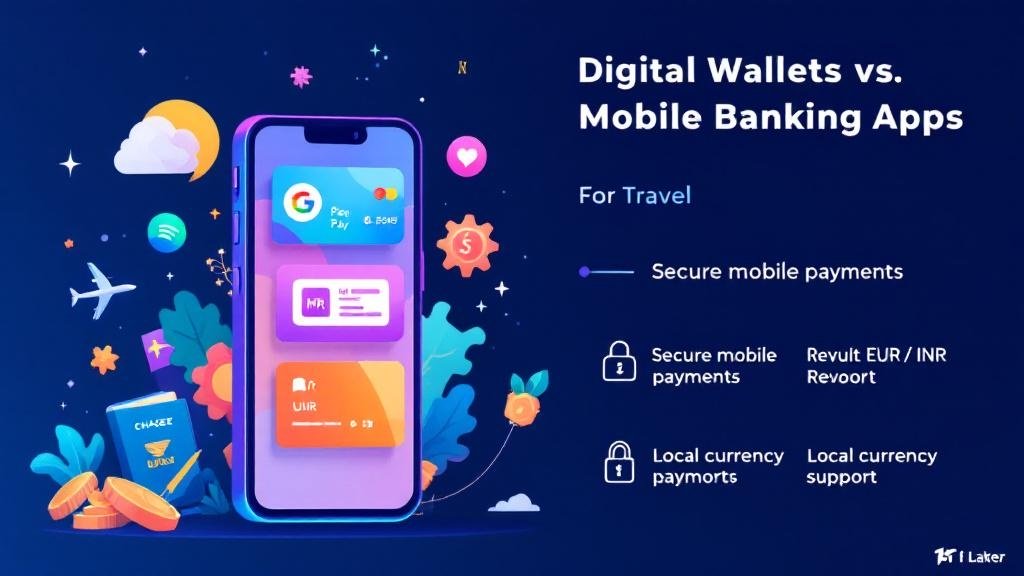Learn the key differences between digital wallets and mobile banking apps. Discover how local currency support, security features, and ease of use make mobile banking apps and digital wallets essential for stress-free travel.
Introduction: The Future of Digital Payments – Local Currency Support in Mobile Banking
The way we handle money is changing rapidly, and one of the most exciting innovations in this space is the rise of mobile banking apps and digital wallets. Whether you’re traveling abroad or managing finances at home, these digital payment systems make transactions simpler and more secure than ever before.
One key feature that is crucial for travelers is local currency support. As more people use mobile payments and digital wallets, understanding the advantages and differences between mobile banking apps and digital wallets can make a world of difference.
In this article, we’ll explore how local currency support in mobile banking apps and digital wallets can enhance your travel experience, the security measures in place, and how you can choose the best digital wallet or mobile banking app for your needs.
What Are Digital Wallets and Mobile Banking Apps?
Before diving into the differences between digital wallets and mobile banking apps, let’s define them:
Digital Wallets: These are apps or software platforms that allow you to store and manage your payment information, such as credit cards, debit cards, and even loyalty cards. Popular examples include Apple Pay, Google Pay, and Samsung Pay.
Mobile Banking Apps: These apps are provided by traditional banks or financial institutions, enabling users to perform banking activities like checking balances, transferring funds, and paying bills. Examples include apps from Chase, HSBC, or SBI.
Though they have overlapping functionalities, mobile banking apps and digital wallets each offer distinct advantages, especially when it comes to local currency support and international transactions.
Digital Wallets vs Mobile Banking Apps: A Side-by-Side Comparison
When deciding between digital wallets and mobile banking apps, it’s important to consider several factors, especially when traveling internationally. Here’s a breakdown of how these two types of platforms stack up against each other.
1. Digital Wallets Comparison: The Pros and Cons
Digital wallets have become a staple for both local and international transactions. They store your payment information securely, and many wallets support multiple currencies, making them ideal for travel.
Pros of Digital Wallets:
Ease of Use: You can link multiple cards and payment methods, including credit, debit, and loyalty cards.
Multiple Currencies: Many digital wallets allow users to store and convert local currencies, which is great for international travel.
Security: Digital wallets use encryption and tokenization, making your financial information harder to steal.
Contactless Payments: You can make NFC-based payments with a simple tap of your smartphone.
Cons of Digital Wallets:
Limited Support: Not all vendors or countries accept digital wallets, especially in rural or remote areas.
Storage Limits: Digital wallets often have limitations on how much money you can store or transfer, making them less ideal for larger transactions.
2. Mobile Banking App Features: Flexibility and Control
Mobile banking apps offer more control over your finances, providing access to your bank’s entire suite of services. Whether you need to check balances, transfer money, or view account statements, mobile banking apps have you covered.
Pros of Mobile Banking Apps:
Full Banking Features: Beyond payments, mobile banking apps allow for transfers, bill payments, and managing savings.
Security: Mobile banking apps often come with strong authentication methods like two-factor authentication (2FA) and biometric security (fingerprint, face recognition).
Local Currency Support: Many mobile banking apps allow you to convert currencies and support local banks worldwide.
Cons of Mobile Banking Apps:
Complex Setup: Setting up a mobile banking app can take longer compared to a digital wallet, as you’ll need to sync multiple accounts and configure security settings.
Limited to Bank’s Network: Unlike digital wallets, which support many financial institutions, a mobile banking app is often limited to a single bank or financial institution.
Digital Wallets vs Traditional Banks: Which Is Better for Travel?
When traveling abroad, the key to stress-free payments is understanding how digital wallets and mobile banking apps interact with your local currency.
Advantages of Mobile Banking Apps:
Global ATM Access: Mobile banking apps allow you to locate ATMs and withdraw local currencies, which is a huge advantage when traveling internationally.
Automatic Currency Conversion: When making international payments, mobile banking apps can convert your home currency to local currency at competitive exchange rates.
Digital Wallets vs Traditional Banks:
Traditional banks often require you to visit physical locations or deal with slower processing times for international transfers. Digital wallets, on the other hand, streamline the process, making it faster to send and receive money internationally. However, digital wallets often come with higher fees for cross-border transactions.
Mobile Payments vs Digital Wallets: Which is More Secure?
Security is a top concern when making mobile payments, especially when traveling. Let’s explore the security features of both mobile banking apps and digital wallets.
Mobile Banking Security vs Digital Wallets:
Both mobile banking apps and digital wallets use advanced security protocols, but there are some key differences:
Encryption and Tokenization: Digital wallets use these technologies to keep your card details safe by replacing them with a secure token. If a hacker intercepts the payment data, they cannot decode the token to steal your information.
Biometric Authentication: Mobile banking apps often offer two-factor authentication and biometric options like face or fingerprint recognition, adding an extra layer of protection for your banking transactions.
Mobile Wallet Encryption:
Whether it’s a mobile banking app or digital wallet, encryption is crucial. Mobile wallet encryption ensures that your sensitive data is stored securely, making it harder for unauthorized parties to access it.
Digital Wallets Pros and Cons: Should You Use Them for Travel?
When it comes to international travel, digital wallets are a convenient and secure option, but they do come with some limitations. Let’s weigh the pros and cons:
Pros:
Convenience: Make payments with a simple tap.
Low Fees: Transactions are often cheaper than credit card payments.
Support for Multiple Currencies: This makes it easier to manage money across borders.
Cons:
Not Universally Accepted: Some vendors still don’t accept digital wallets.
Limited Features: You can’t manage savings or take out loans via a digital wallet.
Best Digital Wallets vs Mobile Banking Apps for 2025
Looking ahead, here are some of the top mobile banking apps and digital wallets for travelers in 2025:
Top Digital Wallets for 2025:
Apple Pay: Supports contactless payments and has extensive international acceptance.
Google Pay: Offers digital wallet services and payment solutions across Android and iOS.
PayPal: Widely accepted, with multi-currency support for international transfers.
Top Mobile Banking Apps for 2025:
Chase Mobile App: Excellent for international travelers, with ATM locators and competitive exchange rates.
Revolut: A global mobile bank with multi-currency support and low transaction fees.
FAQs
1. Can I use digital wallets for international travel?
Yes! Digital wallets like Apple Pay and Google Pay support international payments and multiple currencies, making them great for travel.
2. How secure are mobile banking apps?
Mobile banking apps use advanced security measures, including two-factor authentication, encryption, and biometric verification, to keep your funds safe.
3. Which is better for travel: a digital wallet or a mobile banking app?
It depends on your needs. Digital wallets are great for quick, contactless payments and currency conversion. Mobile banking apps provide more comprehensive banking features, such as access to ATMs and bill payments.
4. Are mobile payments safe with digital wallets?
Yes, mobile payments via digital wallets are generally very safe, thanks to encryption, tokenization, and biometric security features.
5. What’s the difference between NFC payments and digital wallets?
NFC (Near Field Communication) payments refer to the technology used in contactless payments. Digital wallets use NFC to make these payments possible via your smartphone.








Comments (0)